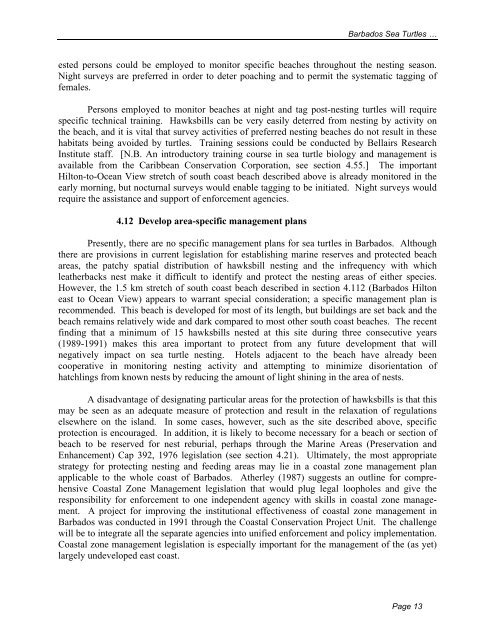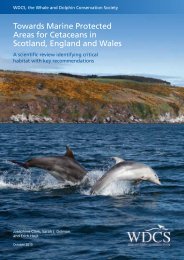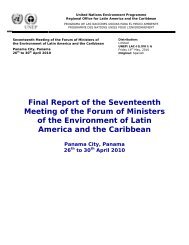Sea Turtle Recovery Action Plan for Barbados - WIDECAST
Sea Turtle Recovery Action Plan for Barbados - WIDECAST
Sea Turtle Recovery Action Plan for Barbados - WIDECAST
Create successful ePaper yourself
Turn your PDF publications into a flip-book with our unique Google optimized e-Paper software.
<strong>Barbados</strong> <strong>Sea</strong> <strong>Turtle</strong>s …<br />
ested persons could be employed to monitor specific beaches throughout the nesting season.<br />
Night surveys are preferred in order to deter poaching and to permit the systematic tagging of<br />
females.<br />
Persons employed to monitor beaches at night and tag post-nesting turtles will require<br />
specific technical training. Hawksbills can be very easily deterred from nesting by activity on<br />
the beach, and it is vital that survey activities of preferred nesting beaches do not result in these<br />
habitats being avoided by turtles. Training sessions could be conducted by Bellairs Research<br />
Institute staff. [N.B. An introductory training course in sea turtle biology and management is<br />
available from the Caribbean Conservation Corporation, see section 4.55.] The important<br />
Hilton-to-Ocean View stretch of south coast beach described above is already monitored in the<br />
early morning, but nocturnal surveys would enable tagging to be initiated. Night surveys would<br />
require the assistance and support of en<strong>for</strong>cement agencies.<br />
4.12 Develop area-specific management plans<br />
Presently, there are no specific management plans <strong>for</strong> sea turtles in <strong>Barbados</strong>. Although<br />
there are provisions in current legislation <strong>for</strong> establishing marine reserves and protected beach<br />
areas, the patchy spatial distribution of hawksbill nesting and the infrequency with which<br />
leatherbacks nest make it difficult to identify and protect the nesting areas of either species.<br />
However, the 1.5 km stretch of south coast beach described in section 4.112 (<strong>Barbados</strong> Hilton<br />
east to Ocean View) appears to warrant special consideration; a specific management plan is<br />
recommended. This beach is developed <strong>for</strong> most of its length, but buildings are set back and the<br />
beach remains relatively wide and dark compared to most other south coast beaches. The recent<br />
finding that a minimum of 15 hawksbills nested at this site during three consecutive years<br />
(1989-1991) makes this area important to protect from any future development that will<br />
negatively impact on sea turtle nesting. Hotels adjacent to the beach have already been<br />
cooperative in monitoring nesting activity and attempting to minimize disorientation of<br />
hatchlings from known nests by reducing the amount of light shining in the area of nests.<br />
A disadvantage of designating particular areas <strong>for</strong> the protection of hawksbills is that this<br />
may be seen as an adequate measure of protection and result in the relaxation of regulations<br />
elsewhere on the island. In some cases, however, such as the site described above, specific<br />
protection is encouraged. In addition, it is likely to become necessary <strong>for</strong> a beach or section of<br />
beach to be reserved <strong>for</strong> nest reburial, perhaps through the Marine Areas (Preservation and<br />
Enhancement) Cap 392, 1976 legislation (see section 4.21). Ultimately, the most appropriate<br />
strategy <strong>for</strong> protecting nesting and feeding areas may lie in a coastal zone management plan<br />
applicable to the whole coast of <strong>Barbados</strong>. Atherley (1987) suggests an outline <strong>for</strong> comprehensive<br />
Coastal Zone Management legislation that would plug legal loopholes and give the<br />
responsibility <strong>for</strong> en<strong>for</strong>cement to one independent agency with skills in coastal zone management.<br />
A project <strong>for</strong> improving the institutional effectiveness of coastal zone management in<br />
<strong>Barbados</strong> was conducted in 1991 through the Coastal Conservation Project Unit. The challenge<br />
will be to integrate all the separate agencies into unified en<strong>for</strong>cement and policy implementation.<br />
Coastal zone management legislation is especially important <strong>for</strong> the management of the (as yet)<br />
largely undeveloped east coast.<br />
Page 13

















